
We critically review the qualification and validation approaches in the World Health Organization Technical Report Series (WHO TRS) 1019 Annex 3 and its applicability to spectrometer systems.

We critically review the qualification and validation approaches in the World Health Organization Technical Report Series (WHO TRS) 1019 Annex 3 and its applicability to spectrometer systems.

This article recaps a recent study into the infrared (IR) spectroscopy market.

Spectroscopy is at the forefront of many changes happening across many industries. Here, two lead investigators comment on how they stay updated with the latest innovations and developments.

This review covers products introduced in the spectroscopy space between May 2023 and April 2024.


The editors of Spectroscopy gathered information about the average salaries and compensation packages compared to previous years. We report on these findings here in our annual salary and employment survey.

Welcome to our Advancing Agriculture for Future Generations content series! Begin your exploration by checking out a compilation of our articles that spotlight how spectroscopy is revolutionizing the agriculture industry.

This year’s Emerging Leader in Atomic Spectroscopy Award recipient is Eduardo Bolea-Fernández. For the past decade, Bolea-Fernández’s research has focused on the development of a newly introduced technique, termed tandem ICP-mass spectrometry (ICP-MS/MS), for ultra-trace elemental and isotopic analysis. Senior technical editor Jerome Workman discusses Bolea-Fernández’s work here.

We interviewed an AI program (ChatGPT) for Spectroscopy asking questions about AI and its role in various applications for vibrational and atomic spectroscopy, including data analysis.

Our annual review of new products for atomic and molecular spectroscopy, including details by category and highlights of overarching trends.

Spectroscopists offer their views on their salaries and the current job market, weighing in on topics such as job security, economic recession, and skill sets of new workers.

Andreas Riedo of the Physics Institute at the University of Bern, the 2023 winner of the Emerging Leader in Atomic Spectroscopy Award, is using laser ablation–desorption ionization mass spectrometry (LIMS) to chemically analyze complex mineral surfaces found in space exploration.

Our annual review of new products for atomic and molecular spectroscopy, including details by category and highlights of overarching trends.

When performing literature searches, there are a number of essential points to remember to ensure that you gather the most relevant or essential papers.

Spectroscopists offer their views on the their salaries and working conditions, including how they are faring through the social and economic challenges still gripping the world.

This issue contains interviews that provide an excellent sampling of the fascinating science that will be presented at this year’s SciX conference.

Dr. Jeanita Pritchett offers insight on how science, technology, engineering, and math (STEM) students can transition into a successful scientific career after graduation.

Click the title above to open the Spectroscopy January regular issue, Volume 36, Issue 1, in an interactive PDF format.
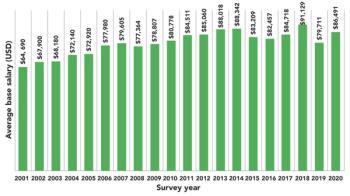
The 2020 Spectroscopy salary and employment survey shows an increase in salaries from previous survey years. Salary, however, does not tell the whole story. We look at broader employment trends, including job satisfaction, workload, workplace bullying, the job market for spectroscopists, and more.
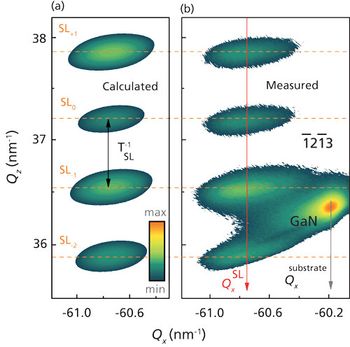
Several leading scientists discuss their work to advance XRF and XRD techniques.

Analytical spectroscopy is a mature field, but advances in instrumentation, measurement, and sample preparation techniques continue to be made. Much recent development has seen a heavy emphasis towards techniques and instrumentation that allow for non-invasive, in-situ, and in-vivo procedures while still retaining a high degree of sensitivity. This article will review some of this progress over the past two to three years across five major spectroscopic fields: Raman, LIBS, XRF, IR, and ICP techniques.

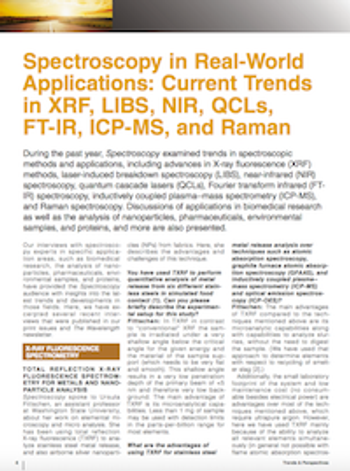
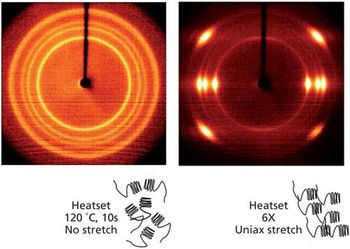
Several leading scientists discuss recent developments and trends in XRF and XRD techniques.
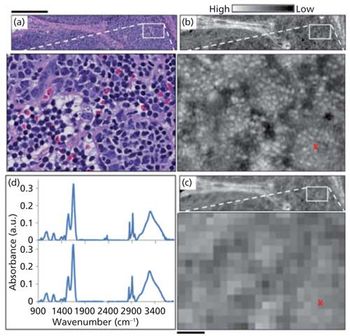
Recent advances in instrumentation have enabled new forms of vibrational chemical imaging, including discrete frequency infrared (DFIR) microscopy and stimulated Raman scattering (SRS) microscopy. These technologies may represent a fundamental shift in how we approach spectroscopic imaging: rather than collecting full spectra which contain redundant information, measuring a few important spectral frequencies may enable significant gains in speed, throughput, signal to noise ratio, and/or image quality. For infrared microscopy, these advantages may be compounded by High Definition IR microscopy. Here we discuss recent advances in infrared and nonlinear Raman imaging through the lens of 'discrete frequency' approaches, including several examples of applications and critical issues in instrumentation that are likely to be dominating research themes in the near future.